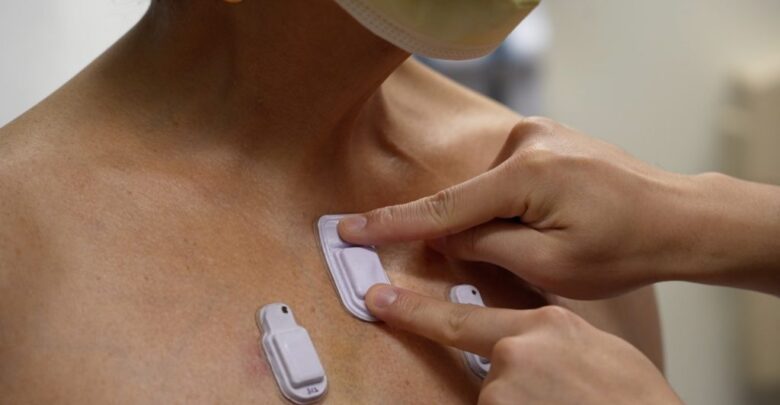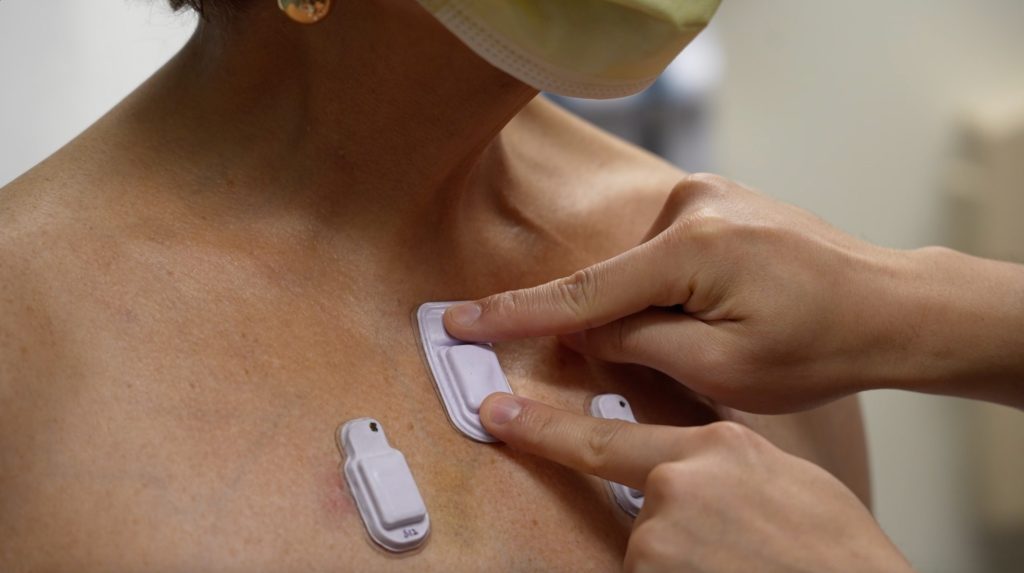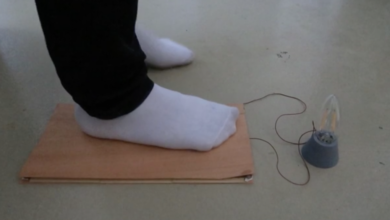

By James Gamble
A new wireless acoustic device developed by scientists can listen to and monitor our bodies better than doctors, potentially saving thousands of lives.
Researchers in the United States developed the wearable device to more closely monitor the vital organs of humans.
The wireless device, which is attached to the body and is able to filter external sounds and focus on those in the body, is pitted to revolutionize health monitoring – especially in premature babies and adults with respiratory diseases.

The medical scientists behind the modern device admit it surpasses the traditional techniques of more than a dozen doctors assessing the health of a patient at once.
The study behind the device, published in the journal Nature Medicine, could drastically help to monitor at-risk patients.
During routine visits for health checks, doctors regularly listen to their patients’ bodies.
Air moving in and out of the lungs, heartbeats and even food progressing down the gastrointestinal tract can offer clues to health professionals.
However, these sounds can often be faint and difficult to track, and external noise can often drown them out.
Therefore, researchers from Northwestern University, in Illinois, developed soft, miniaturised wearable devices which go far beyond the occasional insights obtained by doctors’ examinations.
Softly adhered to the skin, these devices continuously monitor and wirelessly track the sounds at multiple locations across nearly any region of the wearer’s body.
In pilot studies, the research team tested the devices on 15 premature babies with respiratory and intestinal motility disorders, as well as on 55 adults – including around half with chronic lung diseases.
To the researchers’ delight, they found that not only did the devices perform with clinical-grade accuracy, but they also offered new functionalities that have yet to be introduced into research or clinical care.
John Rogers, a bioelectronics pioneer and professor at Northwestern University who led the device development, said: “Currently, there are no existing methods for continuously monitoring and spatially mapping body sounds at home or in hospital settings.
“Physicians have to put a conventional, or a digital, stethoscope on different parts of the chest and back to listen to the lungs in a point-by-point fashion.”
Dr. Ankit Bharat, a thoracic surgeon at Northwestern Medicine who led the clinical research in the adult subjects, added that the new device was akin to having 13 doctors listening and comparing to the wearer’s body at a time.

Dr. Bharat, who performed the first double-lung transplants on COVID-19 patients in the US, said: “The idea behind these devices is to provide highly accurate, continuous evaluation of patient health and then make clinical decisions in the clinics or when patients are admitted to the hospital or attached to ventilators.
“A key advantage of this device is to be able to simultaneously listen and compare different regions of the lungs.
“Simply put, it’s like up to 13 highly trained doctors listening to different regions of the lungs simultaneously with their stethoscopes, and their minds are synced to create a continuous and dynamic assessment of the lung health that is translated into a movie on a real-life computer screen.”
The small, lightweight devices are fitted with pairs of high-performance digital microphones and accelerometers and gently adhere to the skin to create a comprehensive, non-invasive sensing network.
Simultaneously capturing sounds and correlating them to processes in the wearer’s body, the devices spatially map how air flows in and out of the lungs, as well as how cardiac rhythm changes in varied resting and active states and how food, fluid and even gas move through the intestines.
Wrapped in soft silicone, each device measures around 40 millimeters long, 20 millimeters wide and eight millimeters thick.
Within that small footprint, each device contains a flash memory drive, a tiny battery, electrical components, Bluetooth capabilities and two tiny microphones – one facing inward toward the body and another facing outward.
In capturing sounds in both directions, an algorithm can separate external sounds from internal body sounds.
“Lungs don’t produce enough sound for a normal person to hear,” Dr. Bharat explained.
“They just aren’t loud enough, and hospitals can be noisy places. When there are people talking nearby or machines beeping, it can be incredibly difficult.
“An important aspect of our technology is that it can correct for those ambient sounds.”
Capturing ambient noise also provides contextual information about a patient’s surrounding environments, which can be particularly important when treating premature babies, co-first author Dr. Wissam Shalish said.
The neonatologist at the Montreal Children’s Hospital added: “Irrespective of device location, the continuous recording of the sound environment provides objective data on the noise levels to which babies are exposed.
“It also offers immediate opportunities to address any sources of stressful or potentially compromising auditory stimuli.”
In developing their devices, the researchers had two vulnerable patient groups in mind: premature babies in the neonatal intensive care unit (NICU) and post-surgery adults.
In the third and final trimester of pregnancy – at around 28 weeks or seven months -babies’ respiratory systems mature so they are able to breathe outside the womb.
Babies born either before or in the earliest stages of this third trimester are therefore more likely to develop lung issues and disordered breathing complications, such as apnoea.
Apnoeas are a leading cause of prolonged hospitalization and, potentially, death.
When apnoeas occur, infants either do not take a breath due to immature breathing centers in the brain or have an obstruction in their airway that restricts airflow.
Some babies might even have a combination of the two, but there are no current methods to continuously monitor airflow at the bedside and to accurately distinguish apnea subtypes, especially in these most vulnerable infants.
Study co-author Dr. Debra Weese-Mayer said: “Many of these babies are smaller than a stethoscope, so they are already technically challenging to monitor.”
In children and infants, cardiorespiratory and gastrointestinal problems are major causes of death during the first five years of life.
Gastrointestinal issues in particular are accompanied by reduced bowel sounds, which could be used as an early warning sign of digestion issues, intestinal dysmotility and potential obstructions.
Premature babies wore sensors at four locations across their abdomen, and early results aligned with measurements of adult intestinal motility using wire-based systems, which is the current standard of care.
In all patients, the devices simultaneously captured the distribution of lung sounds and body motions at various locations, enabling researchers to analyze a single breath across a range of regions throughout the lungs.
Dr. Bharat said: “With these wireless sensors, we can capture different regions of the lungs and assess their specific performance and each region’s performance relative to one another.
“Eventually we can personalize treatments to individual patients.”
Produced in association with SWNS Talker







